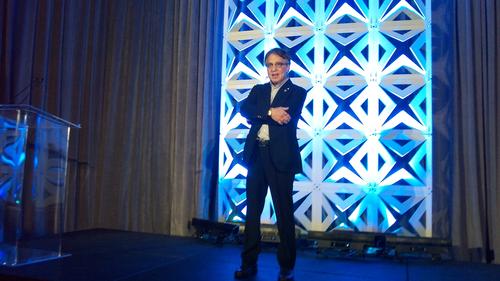'Life Expectancies Will Soar in 20 Years'
Futurist Raymond Kurzweil discussed biotechnology, solar power, and 3D printing at the Pacific Design & Manufacturing Show in Anaheim this week.
February 11, 2016
Human life expectancy, solar power, and 3D printing all have one thing in common: They will follow the exponential growth curve of the information age, futurist Raymond Kurzweil told engineers at the Pacific Design & Manufacturing Show in Anaheim yesterday.
Kurzweil, an accomplished inventor, author, and former Design News Engineer of the Year, told attendees at a keynote speech that a “grand transformation” in medicine will enable scientists to alter human genes and launch nano-robots into the bloodstream, setting the stage for an amazing increase in human lifespan. “According to my models, within 15 years, we will be adding more than a year every year, not just to infant life expectancy, but to your life expectancy,” Kurzweil said. “So as you go forward every year, your life expectancy will be moving away from you.”
Futurist and former National Medal of Technology winner Raymond Kurzweil said that biotechnology, 3D printing, and solar power are all poised for huge growth in the next two decades.
(Source: Design News)
Kurzweil, who now serves as the director of engineering at Google, explained that the transformation will occur because health and medicine are now information technologies, governed by the same exponential growth rate that brought us into the computer age. Citing the success of the Human Genome Project, he said scientists are already learning to turn on and off certain genes in ways that will enable physicians to cure virtually any illness. “Our ability to understand this (genetic) data, to simulate it, to reprogram it, to change this ancient software is growing exponentially,” he said.
Kurzweil also predicted that sophisticated nano-robots will be able to conquer any pathogen –- ranging from cancer cells to viruses to bacteria -– as soon as the 2030s. The cell-sized nano-bots will come complete with sensors, actuators, and computation capabilities, and will be able to enter the body through the blood stream.
The same rapid technological evolution will also apply to solar power, Kurzweil said. Working with Google co-founder Larry Page, Kurzweil studied photovoltaics and said he concluded that solar panels and energy storage capabilities would soon see the same kind of explosive growth that characterized the computer industry. “Four years ago, Larry and I studied solar, and at that point, it made up about a half of a percent of the world’s energy supply,” Kurzweil said. “Now, it’s at 2%.” Kurzweil sees the 2% figure as a sign of imminent growth. Those who consider it a sign of failure are viewing the technology in linear, rather than exponential, terms, he said.
READ MORE ARTICLES FROM PACIFIC DESIGN & MANUFACTURING:
Similarly, Kurzweil said he believes that 3D printing is in a “hype phase” right now, but it, too, will see huge growth in the near future. Within 10 years, he said, 3D-printed clothing will become commonplace. “In the 2020s, you’ll be able to download cool, free open-source clothing designs and print them out at Penney’s,” he said. He also predicted that niche applications for 3D printing will proliferate, especially in the medical world. Artificial hearts, lungs, kidneys, and other organs will be made on 3D printers, he said. “The golden age of 3D printing will be starting in the 2020s,” he said.
Kurzweil, who notably foresaw the emergence of the Internet, acknowledged that many futurists disagree with his technological predictions. But he argued that those critics are looking at the future on a linear scale, instead of an exponential one. “They’re ignoring the exponential growth, just as they ignored the exponential growth of the Internet and the genome project,” he said.
Senior technical editor Chuck Murray has been writing about technology for 31 years. He joined Design News in 1987, and has covered electronics, automation, fluid power, and autos.

About the Author(s)
You May Also Like


.jpg?width=300&auto=webp&quality=80&disable=upscale)

